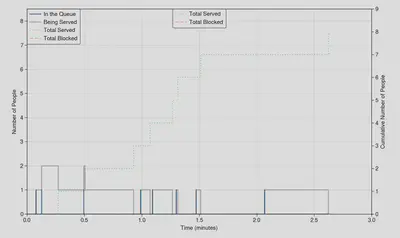Simulating Queueing with SimPy in Python
A simulation of a queueing system using the SimPy library in Python.
A simulation of a queueing system using the SimPy library in Python.

Queueing theory gives us a way to model the behaviour of queues in real life. It is used in many applications, such as traffic flow, call centres, and computer networks. In this post, I will show how I simulated a queueing system using the SimPy library in Python.
The Problem
Queueing happens any time we have a system where inputs are received at random or regular times, and these inputs take some time to process with finite processing power, before being output from the system. In a conventional queue at a shop for example, the inputs are the customers, the processing is being served by the shop staff, and the output is leaving with the shopping. At different times of the day, the number of customers arriving will vary, and the time taken to serve each customer will vary too. This means that the length of the queue will vary throughout the day. How can the shop decide how many servers should be present at any given time to minimise the average queue length? Queueing theory gives the tools to solve problems like this.
Queueing Theory
A simple starting point queueing model is as follows:

This shows how inputs from a population can enter a queue to be served by any number of servers. It is often assumed that arrival times and service times are exponentially distributed, which corresponds to arrivals occuring according to a Poisson point process.
A generalised single queue system can be denoted as $ M/M/c/N/K $, where:
- the first $ M $ indicates a Markovian distribution (aka exponential) for the arrival times
- the second $ M $ indicates the same for the service times
- $ c $ is the number of servers
- $ N $ is the maximum number of customers allowed in the system (queue + servers)
- $ K $ is the number of people in the population.
Theoretical results for the M/M/c/N queue can be found here.
Simulation using Python (SimPy)
First, the modules that we’ll be using.
import simpy # the main library, for discrete event simulation
import matplotlib.pyplot as plt # for plotting results
from matplotlib.animation import FuncAnimation # make a real-time animated plot
from matplotlib.ticker import MultipleLocator
import random # to generate random arrival and service times
import math # for computing theoretical results
import itertools # for calculating cumulative sums of results
import logging # for recording times of events
Now we’ll define the Queue class and set up logging. The env parameter is a SimPy environment instance that we will pass in at runtime.
class QueueSim:
_LOG_FILE = 'queue_log.txt'
def __init__(self, lambda_: float = 1, mu: float = 1, c: int = 1,
N: int = float('inf'), K: int = float('inf'),
env: simpy.Environment = None):
'''
Define an M/M/c/N/K queue, a continuous-time Markov chain (CTMC) and stochastic process
in which 'customers' from a 'population' arrive and are served according to a Poisson point process, with options for a finite queue size and finite population size.
#### Arguments
- `lambda_` (float, default = 1): the rate parameter for customers attempting to
enter the system.
- `mu` (float, default = 1): the rate parameter for each customer leaving a service node.
- `c` (int, default = 1): the number of service nodes.
- `N` (int, default = float('inf')): the maximum possible size of the system, so
that the maximum queue length is `N - c`. If unset, the size is unlimited.
- `K` (int, default = float('inf')): the maximum possible size of the population.
If `K = N` then the queue is closed, so that customers leaving the service node
immediately may wish to enter the queue again.
- `env` (simpy.Environment, default = None): a `SimPy` environment instance to use
in this simulation.
'''
self.env = simpy.Environment() if env is None else env
self.server = simpy.Resource(self.env, capacity=c)
self.queue = simpy.Store(self.env) if N == float('inf') else simpy.Store(self.env, capacity=N - c)
self.lamda = lambda_
self.mu = mu
self.c = c
self.K = K
self.N = N
self.num_people_served = 0 # people who entered the queue, went to a server, and left
self.num_people_blocked_data = [(0, 0)] # people who tried to enter but found a full queue, so did not get served never got served
self.results = {}
self.init_logger()
def init_logger(self):
self.logger = logging.getLogger(__name__)
self.logger.setLevel(logging.DEBUG)
file_formatter = logging.Formatter('%(asctime)s - %(levelname)s - %(message)s')
file_handler = logging.FileHandler(self._LOG_FILE)
file_handler.setFormatter(file_formatter)
self.logger.addHandler(file_handler) # send logs to file
Next, we’ll make a generator that constantly yields customers. We also write a method to serve customers separately.
def generate_arrivals_forever(self, end_condition_customers: int = float('inf')) -> simpy.events.Timeout:
'''
_summary_
### Optional Arguments
- `end_condition_customers` (int, default = float('inf')): optionally stop the simulation after a
given number of customers are served.
### Yields
- `Iterator[simpy.events.Timeout]`: waits the inter-arrival time between customers.
'''
id_num = 0
while True:
# wait for the next customer
inter_arrival_time = random.expovariate(self.lamda)
yield self.env.timeout(inter_arrival_time) # wait a random entry time
# check there are some customers in the population - if not, cycle
is_people_in_population = (self.K - len(self.queue.items) + len(self.server.users) > 0)
if not is_people_in_population:
continue
# a wild customer appears! Can they fit in the queue?
if len(self.queue.items) < self.queue.capacity:
# admit to queue and enter process for them
self.logger.info(f'Customer {id_num} admitted into queue at {self.env.now}')
self.results.update({id_num: [self.env.now, None, None, True]})
self.queue.put(id_num)
self.env.process(self.process_customer(id_num))
else:
# record their attempted entry but do not enter the queue
self.logger.info(f'Customer {id_num} blocked from queue at {self.env.now}')
self.num_people_blocked_data.append((self.env.now, self.num_people_blocked_data[-1][1] + 1))
self.results.update({id_num: [self.env.now, None, None, False]})
# end simulation if end condition met
if id_num >= end_condition_customers:
self.logger.info(f'Customer {id_num} is the last customer allowed in.')
break
id_num += 1
def process_customer(self, id_num):
# serve a customer at the front of the queue
with self.server.request() as request:
yield request
_id_moved = self.queue.get() # remove this customer from the queue
self.logger.info(f'Customer {id_num} began being served at {self.env.now}')
self.results[id_num][1] = self.env.now # time moved to the counter
service_time = random.expovariate(self.mu)
yield self.env.timeout(service_time)
self.logger.info(f'Customer {id_num} finished at {self.env.now}')
self.results[id_num][2] = self.env.now # time left the system
self.num_people_served += 1
We would like to record the wait times in our simulation, and compare them to standard steady-state results for our system.
def get_statistics(self):
# calculate wait times per customer
system_wait_times, queue_wait_times, service_times = zip(*[
[val[2] - val[0], val[1] - val[0], val[2] - val[1]] for _, val in self.results.items() \
if all([x is not None for x in val])])
mean_queue_wait_time = sum(queue_wait_times) / len(system_wait_times)
# calculate queue lengths
join_times = [(1, val) for val in [data[0] for data in self.results.values() if data[3]]]
leave_times = [(-1, val) for val in [data[1] for data in self.results.values() if data[3]]]
leave_times = list(filter(lambda x: x[1] is not None, leave_times))
change_times = sorted(join_times + leave_times, key=lambda x: x[1])
queue_changes = [c[0] for c in change_times]
queue_cumulative_changes = itertools.accumulate(queue_changes)
queue_lengths = [(0, 0)] + [(total, time) for (total, (_, time)) in \
zip(queue_cumulative_changes, change_times)]
# get time weighted average queue length
time_sum = 0
for x, y in zip(queue_lengths[:-1], queue_lengths[1:]):
time_sum += x[0] * (y[1] - x[1])
mean_queue_length = time_sum / queue_lengths[-1][1]
# get theoretical stats
expected_queue_time, expected_queue_length = self.get_theoretical_statistics()
print(f'Queue length: Simulated {mean_queue_length}, Theoretical {expected_queue_length}, '
f'Diff {100 * (1 - mean_queue_length / expected_queue_length):.4f}%')
print(f'Queue time: Simulated {mean_queue_wait_time}, Theoretical {expected_queue_time}, '
f'Diff {100 * (1 - mean_queue_wait_time / expected_queue_time):.4f}%')
def get_theoretical_statistics(self):
'''
Only valid for M/M/c/N queue (K is infinite)
'''
rho = self.lamda / (self.c * self.mu) # server utilisation
pi_0 = (1 + sum([(self.c * rho) ** n / math.factorial(n) for n in range(1, self.c + 1)])
+ (self.c * rho) ** self.c / math.factorial(self.c) * sum([
rho ** (n - self.c) for n in range(self.c + 1, self.N + 1)
])) ** -1
pi_n = lambda n: pi_0 * (self.c * rho) ** n / math.factorial(n) if 0 <= n < self.c \
else pi_0 * (self.c * rho) ** n * self.c ** (self.c - n) / math.factorial(self.c)
pi_N = pi_0 * (self.c * rho) ** self.N / (math.factorial(self.c) * self.c ** (self.N - self.c))
E_queue_length = pi_0 * (self.c * rho) ** self.c * rho / (math.factorial(self.c) * (1 - rho) ** 2) * (
1 - rho ** (self.N - self.c) - (self.N - self.c) * (1 - rho) * rho ** (self.N - self.c)
)
lambda_eff = self.lamda * (1 - pi_N)
E_queue_time = E_queue_length / lambda_eff # Little's lemma
return E_queue_time, E_queue_length
We can now animate the process in real time too:
def animate_queue_length(self, window_size: float = 1):
fig, ax1 = plt.subplots(figsize=(10, 6))
ax2 = ax1.twinx()
ax1.set_xlabel("Time (minutes)")
ax1.set_ylabel("Number of People")
ax1.set_ylim(0, self.N - self.c + 0.5)
ax1.yaxis.set_major_locator(MultipleLocator(base=1.0))
ax1.minorticks_off()
ax2.set_ylabel("Cumulative Number of People")
ax2.yaxis.set_label_position("right")
ax2.yaxis.tick_right()
ax2.grid(False)
ax2.minorticks_off()
self.event_timepoints = []
self.num_people_served_data = []
self.queue_length_data = []
self.server_length_data = []
# Initialize the plot lines
line_queue, = ax1.plot([], [], label='In the Queue')
line_server, = ax1.plot([], [], color='black', alpha=0.3, label='Being Served')
line_served, = ax2.plot([], [], color='green', linestyle=':', alpha=0.3, label='Total Served')
line_blocked, = ax2.plot([], [], color='red', linestyle='--', alpha=0.3, label='Total Blocked')
def init():
line_queue.set_data([], [])
line_server.set_data([], [])
line_served.set_data([], [])
line_blocked.set_data([], [])
return line_queue, line_server, line_served, line_blocked
def update(frame):
if self.env.peek() is not simpy.core.Infinity:
self.env.step()
else:
return
queue_length = len(self.queue.items)
server_length = len(self.server.users)
self.queue_length_data.append((self.env.now, queue_length))
self.server_length_data.append((self.env.now, server_length))
self.num_people_served_data.append((self.env.now, self.num_people_served))
self.num_people_blocked_data.append((self.env.now, self.num_people_blocked_data[-1][1]))
self.event_timepoints.append(self.env.now)
# add data points before step changes to make to the plot
# look like rectangles rather than lines joining points
for attr in ['queue_length_data', 'server_length_data', 'num_people_served_data', 'num_people_blocked_data']:
if frame != 0 and getattr(self, attr)[-1][1] != getattr(self, attr)[-2][1]:
getattr(self, attr).insert(-1, (self.env.now, getattr(self, attr)[-2][1]))
ax1.set_xlim(max(0, self.env.now - window_size), max(window_size, self.env.now))
ax2.set_ylim(0, max(self.num_people_served, self.num_people_blocked_data[-1][1]) + 1)
line_queue.set_data(*zip(*self.queue_length_data))
line_server.set_data(*zip(*self.server_length_data))
line_served.set_data(*zip(*self.num_people_served_data))
line_blocked.set_data(*zip(*self.num_people_blocked_data))
ax1.relim()
ax1.autoscale_view()
ax2.relim()
ax2.autoscale_view()
return line_queue, line_server, line_served, line_blocked
ani = FuncAnimation(fig, update, init_func=init, interval=30, blit=False)
# Manually create a single legend for both axes
lines = [line_queue, line_server, line_served, line_blocked]
labels = [line.get_label() for line in lines]
ax1.legend(lines, labels, loc='upper left')
ax2.legend(loc='upper center')
plt.show()
And now we can run:
def main():
q = QueueSim(lambda_=5, mu=3, c=2, N=10)
q.env.process(q.generate_arrivals_forever()) # process the generator
q.animate_queue_length(window_size=3) # animate at each yield from the generator
q.get_statistics()
if __name__ == '__main__':
main()
A screenshot from the animation (cannot show animations easily here…)

Here’s a sample from the log file showing how we recorded the events:
2023-08-30 10:14:51,888 - INFO - Customer 0 admitted into queue at 0.07968689242355713
2023-08-30 10:14:52,365 - INFO - Customer 0 began being served at 0.07968689242355713
2023-08-30 10:14:52,678 - INFO - Customer 1 admitted into queue at 0.128119429755327
2023-08-30 10:14:53,049 - INFO - Customer 1 began being served at 0.128119429755327
2023-08-30 10:14:53,260 - INFO - Customer 1 finished at 0.2727061089992237
2023-08-30 10:14:53,580 - INFO - Customer 2 admitted into queue at 0.4943649913915312
2023-08-30 10:14:53,888 - INFO - Customer 2 began being served at 0.4943649913915312
2023-08-30 10:14:54,080 - INFO - Customer 0 finished at 0.5041083654489577
2023-08-30 10:14:54,355 - INFO - Customer 2 finished at 0.9274427514476721
2023-08-30 10:14:54,643 - INFO - Customer 3 admitted into queue at 0.988933676368025
2023-08-30 10:14:55,061 - INFO - Customer 3 began being served at 0.988933676368025
2023-08-30 10:14:55,380 - INFO - Customer 3 finished at 1.0715969343708087
After a very long time, the simulation will approach the theoretical steady-state results. However, for smaller times, there is an initialisation bias, since we start with an empty system instead of steady state. This can be overcome by only starting recording after a certain warm-up period has passed, but I didn’t bother with this here.
Full code in one file on my GitHub repo here.